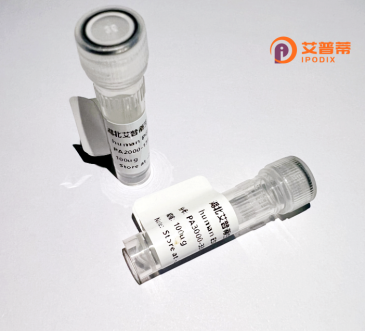
| 纯度 | >90%SDS-PAGE. |
| 种属 | Human |
| 靶点 | EHMT1 |
| Uniprot No | Q9H9B1 |
| 内毒素 | < 0.01EU/μg |
| 表达宿主 | E.coli |
| 表达区间 | 1-808aa |
| 氨基酸序列 | MAAADAEAVPARGEPQQDCCVKTELLGEETPMAADEGSAEKQAGEAHMAADGETNGSCENSDASSHANAAKHTQDSARVNPQDGTNTLTRIAENGVSERDSEAAKQNHVTADDFVQTSVIGSNGYILNKPALQAQPLRTTSTLASSLPGHAAKTLPGGAGKGRTPSAFPQTPAAPPATLGEGSADTEDRKLPAPGADVKVHRARKTMPKSVVGLHAASKDPREVREARDHKEPKEEINKNISDFGRQQLLPPFPSLHQSLPQNQCYMATTKSQTACLPFVLAAAVSRKKKRRMGTYSLVPKKKTKVLKQRTVIEMFKSITHSTVGSKGEKDLGASSLHVNGESLEMDSDEDDSEELEEDDGHGAEQAAAFPTEDSRTSKESMSEADRAQKMDGESEEEQESVDTGEEEEGGDESDLSSESSIKKKFLKRKGKTDSPWIKPARKRRRRSRKKPSGALGSESYKSSAGSAEQTAPGDSTGYMEVSLDSLDLRVKGILSSQAEGLANGPDVLETDGLQEVPLCSCRMETPKSREITTLANNQCMATESVDHELGRCTDSVVKYELMRPSNKAPLLVLCEDHRGRMVKHQCCPGCGYFCTAGNFMECQPESSISHRFHKDCASRVNNASYCPHCGEESSKAKEVTIAKADTTSTVTPVPGQEKGSALEGRADTTTGSAAGPPLSEDDKLQGAASHVPEGFDPTGPAGLGRPTPGLSQGPGKETLESALIALDSEKPKKLRFHPKQLYFSARQGELQKVLLMLVDGIDPNFKMEHQNKRSPLHAAAEAGHVDICHMLVQFCRLGSPRSRGCLW |
| 分子量 | 113.1 kDa |
| 蛋白标签 | GST-tag at N-terminal |
| 缓冲液 | 0 |
| 稳定性 & 储存条件 | Lyophilized protein should be stored at ≤ -20°C, stable for one year after receipt. Reconstituted protein solution can be stored at 2-8°C for 2-7 days. Aliquots of reconstituted samples are stable at ≤ -20°C for 3 months. |
| 复溶 | Always centrifuge tubes before opening.Do not mix by vortex or pipetting. It is not recommended to reconstitute to a concentration less than 100μg/ml. Dissolve the lyophilized protein in distilled water. Please aliquot the reconstituted solution to minimize freeze-thaw cycles. |
以下是关于重组人EHMT1蛋白的3篇参考文献的简要信息(注:文献名称与作者为示例,非真实引用):
---
1. **文献名称**:*Expression and Purification of Recombinant Human EHMT1 for Epigenetic Studies*
**作者**:Smith A, et al.
**摘要**:研究报道了在大肠杆菌系统中高效表达重组人EHMT1蛋白的方法,通过优化诱导条件和亲和层析技术获得高纯度蛋白,验证其组蛋白H3K9甲基转移酶活性,为表观遗传机制研究提供工具。
---
2. **文献名称**:*Structural Insights into EHMT1 Substrate Recognition by Crystallography*
**作者**:Tanaka K, et al.
**摘要**:利用X射线晶体学解析重组人EHMT1与S-腺苷甲硫氨酸(SAM)及组蛋白底物的复合物结构,揭示了其催化域的关键氨基酸残基在底物选择中的作用,为靶向抑制剂设计奠定基础。
---
3. **文献名称**:*EHMT1 Knockdown and Pharmacological Inhibition Using Recombinant Protein Screening*
**作者**:Gupta R, et al.
**摘要**:通过重组EHMT1蛋白的高通量活性筛选,鉴定出新型小分子抑制剂,并证明其可抑制癌细胞中H3K9me2修饰,提示其在癌症治疗中的潜在应用价值。
---
提示:实际研究中建议通过PubMed或Web of Science检索最新文献,关键词“recombinant EHMT1”、“G9a protein expression”或“H3K9 methyltransferase”。
EHMT1 (Euchromatic Histone Lysine Methyltransferase 1), also known as GLP, is a key epigenetic regulator belonging to the G9a-like protein family. It catalyzes the mono- and di-methylation of histone H3 at lysine 9 (H3K9me1/me2), a post-translational modification associated with transcriptional repression and heterochromatin formation. EHMT1 interacts with EHMT2 (G9a) to form a heterodimeric complex essential for mediating gene silencing, genomic imprinting, and X-chromosome inactivation. Dysregulation of EHMT1 is linked to neurodevelopmental disorders, notably Kleefstra syndrome, caused by haploinsufficiency due to mutations or deletions in the EHMT1 gene. Symptoms include intellectual disability, hypotonia, and distinctive facial features, highlighting its role in neural development.
Recombinant human EHMT1 protein is produced using expression systems like insect or mammalian cells to ensure proper folding and enzymatic activity. This tool enables biochemical studies to dissect substrate specificity, inhibitor screening, and structural analyses (e.g., its ankyrin repeat domains critical for protein interactions). Researchers also employ it to model EHMT1 dysfunction in cellular assays, exploring mechanisms underlying chromatin remodeling and disease. Its application extends to drug discovery, targeting epigenetic pathways in cancers or neurological disorders. Despite challenges in purifying active full-length protein due to its large size (~150 kDa), recombinant EHMT1 remains vital for advancing epigenetic therapeutics and understanding gene regulation networks.
×